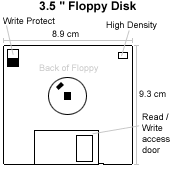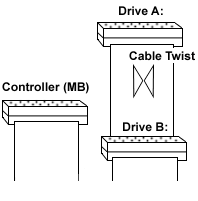|
|
Basic
floppy trouble shooting
A floppy drive may not work because of one or more of the following
reasons.
- Bad floppy diskette.
- Not setup in CMOS.
- Confliction with other hardware.
- Not connected properly.
- Bad drivers.
- Bad hardware.
Bad floppy diskette.
Verify that the floppy diskette that you are attempting to read from
is not write protected or bad. Verify that the diskette is not write
protected by sliding the tab into the position not allowing light to
shine through it. If you do not have a tab place tape over this hole.

Because of the technology of floppy diskette drives it is likely for
a floppy diskettes to easily become bad. Verify that other floppy
diskettes are not exhibiting the same issue.
If other floppies work it is likely that you may have a bad floppy
diskette.
Not setup in CMOS.
Verify that the floppy drive is properly setup in CMOS. If the floppy
drive is not setup properly you may experience read / write errors or
the floppy may not work at all. Most computers need to have the floppy
setup as a 3.5, 1.44MB.
Confliction with other hardware.
If you have recently physically installed any new hardware such as a
tape drive or other backup medium temporarily disconnect that new
hardware to ensure that it is not the cause of your floppy drive not
working.
Not connected properly.
 | Open computer being aware of ESD
and its potential dangers.
 | Verify that the floppy connection is connected to the motherboard
FDD connector. If it appears to be connected disconnect and
reconnect cable to verify cable is seated properly.
 | Verify that the floppy cable coming from the motherboard is
connected to the back of the floppy drive. If connected disconnect
and connect the floppy drive cable to verify seated properly.
 | Verify that a power connection is also connected to the back of
the floppy drive. |
| | |

 | If your floppy cable has more then one connection verify that your
are connected the floppy to the appropriate connection. The above
picture illustrates what drive should be connected where. |
Bad drivers.
If you are not able to read or write to a floppy diskette from
Windows, verify that the computer is not exhibiting floppy drivers issue
by testing the floppy drive from MS-DOS.
If you are running Windows 3.x click File and click Exit Windows to
get to an MS-DOS prompt.
If you are running Windows 95, Windows 98, Windows NT or Windows 2000
click Start / Shutdown and restart the computer to a MS-DOS prompt.
Once at the prompt place a diskette into the floppy disk drive and
type format a: if you get:
Invalid media or Track 0 Bad = Attempt to format another floppy
disk.
Write Protect Error = Ensure that the disk is not write protected; by
removing the floppy disk and insuring that you cannot see through both
holes if you can; move the tab in the left hand side down (looking
from he back of the floppy) and try again. If the disk is not write
protected try another floppy disk.
Invalid drive specification = Ensure that you floppy drive is setup
properly in CMOS.
If the floppy disk drive formats properly in MS-DOS however does not
format in Windows it is likely that Windows or a program within Windows
is preventing the floppy drive from working. Attempt to End task al
running TSRs by following the step on document CHTSR.
If you continue to experience the same issues we recommend that Windows
be reinstalled.
Bad hardware.
If you continue to experience issues after following the above steps
it is likely that hardware within the computer is bad. Attempt to
replace the following hardware in the computer in the below order.
- Replace the floppy data cable which connects the computer floppy
drive to the motherboard \ I/O board.
- Replace the floppy if the floppy data cable did not resolve your
issues.
- Replace or request that the motherboard \ I/O board be replaced
MORE INFORMATION
If you are having problems with a floppy disk drive (such as receiving
the error message "Error reading drive <X>:" or if the
status of your floppy disk drive in Device Manager is listed in MS-DOS
Compatibility mode), try the troubleshooting tips in the following
sections.
Safe Mode
Start Windows in Safe mode and try to access the floppy disk drive. To
start Windows 95 in Safe mode, restart your computer, press the F8 key
when you see the "Starting Windows 95" message, and then
choose Safe Mode from the Startup menu. To start Windows 98 in Safe
mode, restart your computer, press and hold down the CTRL key after your
computer completes the Power On Self Test (POST), and then choose Safe
Mode from the Startup menu.
If you can access the floppy disk drive, follow these steps:
- Use the right mouse button to click My Computer, then click
Properties on the menu that appears.
- Click the Device Manager tab.
- Double-click Floppy Disk Controllers.
- Click the floppy disk controller for the drive you are having
problems with, then click Properties.
- In Windows 95, click the Original Configuration (Current) check
box to clear it. In Windows 98, click the Disable In This Hardware
Profile check box to select it. This disables the Windows
protected-mode driver for the floppy disk drive controller.
- Click OK.
- Restart Windows normally.
If you can access the floppy disk drive successfully after following the
above steps, the following conditions may be true:
- The floppy disk drive controller may not be supported in protected
mode.
- There are drivers loading in the Config.sys or AUTOEXEC.BAT file
that may be necessary for protected-mode access.
- There are drivers loading in the CONFIG.SYS or AUTOEXEC.BAT file
that may be causing conflicts in Windows and need to be disabled.
If you still cannot access the floppy disk drive after following steps
1-7, follow these steps:
- Use the right mouse button to click My Computer, then click
Properties on the menu that appears.
- Click the Device Manager tab.
- Double-click Floppy Disk Controllers.
- Click the floppy disk controller, and then click Remove to remove
the controller.
- Click OK.
- In Control Panel, double-click Add New Hardware.
- Click Next, and then click Yes to allow Windows to detect the
hardware in your computer.
- When the Add New Hardware Wizard is finished, restart the computer
and try to access the floppy disk drive again.
Redetecting the floppy disk controller should resolve any addressing
problems with the controller by detecting the correct address range. If
the floppy disk controller is not detected correctly, there may be a
problem with the floppy disk controller. If the floppy disk controller
is redetected but you still cannot access the floppy disk drive, there
may be a problem with the floppy disk.
Device Conflicts
Device conflicts as reported by Device Manager can cause problems
reading from and writing to floppy disks. You can resolve this problem
by changing or removing the resources from Device Manager that are
causing the conflict. These are typically conflicts with hard drive
controller cards, video cards, or COM ports.
|

![]()